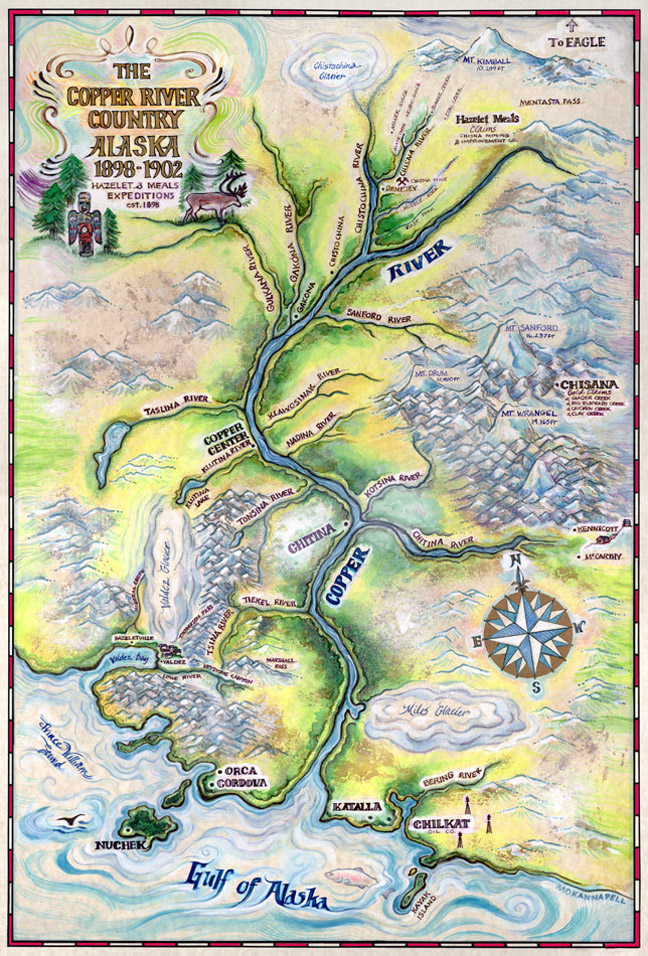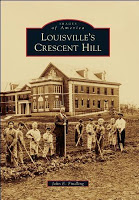 |
| Hazelet-Meals Expedition on the trail, c 1898. Courtesy of Hazelet-Clark families. |
By Keith Waits
Entire contents copyright 2013 by Keith Waits, all rights reserved.
One hundred years after Lewis and Clark’s Corps of Discovery, the American frontier seemed to be dwindling fast, as civilization fully occupied the shores of the Pacific and Manifest Destiny was, essentially, made a reality. At the dawn of the 20th century, the opportunity for such discovery and exploration was harder to come by. Yet for those determined few, the gold rush in the Alaska territory beckoned
John Clark grew up knowing his great-grandfather, George Cheever Hazelet, had spent several years in Alaska. Special hand-stitched leather-bound editions of the journals he kept during that period had made the rounds within his family since they were produced around 50 years ago, but Clark only found the time to sit and read through them in the1990s. It was a profound discovery of family history that would lead to the recent publication of Hazelet’s Journal through Clark’s new publishing company, Old Stone Press.
At first it struck Clark as “…a quiet, little American story.” But eventually he began to see it as emblematic of the pioneer spirit of the times – a spirit that was sometimes borne, Clark admits, from adversity. While living in Nebraska, Hazelet had primarily been a schoolteacher. But various other business ventures had met with misfortune, and by 1898, “He had run his string out,” says Clark. His journey to Alaska, often under the most horrible conditions, brought him to Valdez, where his attempts to mine for gold resulted in something less than the fortune he had hoped for. Still, as so many hardscrabble entrepreneurs would, he soldiered on and, if he did not strike it rich exactly, he did take a meaningful role in fashioning a social community further down the coast at Cordova. Hazelet helped lay out the town, became its first mayor, invested in real estate and oil, was a partner in founding the Cordova Power & Light Company, ran for governor, and was an early candidate for territory state senator.
That all of this is so well-documented reflects the great importance of written communication in the Victorian era. The written word held great value among all classes of society, with letters and journals a commonplace and vital means of staying in touch or, in this instance, of reporting back to family members who had invested in the expedition. A responsibility met with a literary sophistication contrasting against an undeveloped world defined by a rough-and-tumble crudity. Today, such an adventure would undoubtedly be recorded for posterity with digital cameras instead of the vivid, fluid, documentary prose that flows from Hazelet’s pen.
 |
| The Copper Rive Country. Hazelet-Meals Expedition. Copyright J.H. Clark, 2012. Illustration by Mary Dennis Kannapell. |
The author’s words paint memorable and detailed pictures, but Hazelet also packed a camera when he left Nebraska. So the handsomely designed volume is profusely illustrated with his own black and white photographs, augmented by several images culled by Clark from the archives of the University of Alaska and other sources. Many of them have never been published.
Clark turned to several friends and acquaintances to contribute and insure the quality of the final product: Doug Kenny, Military Channel founder and author of over 15 books on WWII and the “cold” wars, contributed the foreword; Elizabeth Perry Spalding and 21 Skye Design fashioned a rich and elegant package; and local artist Mary Dennis Kannapell was recruited to provide a critical map illustration.
Hazelet’s Journal proves to be a tale of real grit and determination, a piece of history seen through the eyes of one hardy individual who placed himself at a turning point in the development of the Alaskan wilderness – to some the “last frontier” in our American history.
John Clark will be at Carmichael’s Bookstore July 19 at 7 p.m. for a book signing and discussion of Hazelet’s Journal.
Carmichael’s Bookstore
2720 Frankfort Avenue
Hazelet’s Journal
By George Cheever Hazelet
Edited by John H. Clark
Published by Old Stone Press
308 pages
four photo wells
$29.95 (hardcover)




